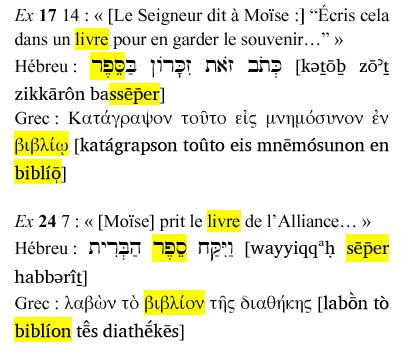
Excerpt of Regnat Magazine
Let's Adore Jesus-Eucharist! | Home >> Varia >> Software Engineering

Excerpt of
Regnat Magazine
Displaying and writing Greek characters on a web page requires knowledge of Unicode and Greek, which I don't know much about. Nevertheless, here is how I currently do it.
1.1) Download the free Gentium font (".ZIP" file, approx. 1 Meg).
1.2) Unzip the downloaded file.
1.3) Install the fonts by going to "Start/Control Panels/Fonts", then "File/Install New Font", and navigating to the ".TTF" files you've just unzipped.
If you only have a few Greek words to add once in a while, you can use this relatively simple method:
2.1) Make sure your browser has Greek fonts installed! See here above.
2.2) Modify your actual web page. Add the following code to each page in which you want to display Greek fonts (or to the CSS file used by those pages):
<head> // ... your usual stuff here <style type="text/css"> span.grec { font-family:Gentium, OdysseaU, GraecaUBSU; font-size:110%; } </style> </head>
2.3) Download the free BabelMap Unicode Character Map Utility (".ZIP" file, approx. 1.1 Meg).
2.4) In the drop-down list called "Select Unicode Block", choose "Greek and Coptic" (for simple letters) or "Greek Extended" (for letters with complicated diacritical marks).
2.5) In the "Edit Buffer" at the bottom, choose the radio button called "NCR (decimal)".
2.6) Click on the letters you want, and then copy-paste the weird codes from the "Edit Buffer" to your web page. Surround those weird codes with the appropriate "span" tags, like this:
<span class="grec">Ηελλο ωυρλδ!</span>
If you have installed the proper fonts, you should see: Ηελλο ωυρλδ! (or "Hello Ourld", which in French sounds vaguely like the classic "Hello world" of programmers; Greek doesn't have a "W").
If you have a lot of Greek text to write, or if you must mix languages like English, Greek and Hebrew, the plot thickens! (Starting here, it's Mr. Philippe Guidal of Regnat Magazine who is speaking, since I'm totally out of my league here.)
I don't think there's a simple solution to input text with several different alphabetical systems, such as English, Greek and Hebrew. The recent versions of Microsoft Word theoretically permit such an exercise, but the additional modules which must be installed are not really adapted to biblical texts, which are the ones I'm interested in. Specifically, biblical Hebrew - apart from its right to left writing - uses a very complex accentuation system (about fifty signs, for the most frequent) and five letters that have two forms, depending on their position (final or not) in a word.
The solution I'm proposing here might only be a kludge, but you get used to it very quickly.
The Summer Institute of Linguistics (www.sil.org) proposes two packages, respectively for Greek and Hebrew, based on the use of a keyboard manager, Keyman by TavulteSoft (www.tavultesoft.com. Not the most recent version (7.0, not free), but the free 6.0 version... Officially, this 6.0 version doesn't work with Windows Vista; in fact, it works quite well.)
On the other hand, and you must be aware of this, the relevant use of the SIL packages assumes and requires a minimum knowledge of the target languages (in this case, Greek and Hebrew, but the process is the same for other linguistic resources provided by the SIL).
The download links are:
Greek:
scripts.sil.org/SILGrk_home
or:
scripts.sil.org/cms/scripts/page.php?site_id=nrsi&item_id=SILGrk_home
Hebrew:
scripts.sil.org/SILEzra
or:
scripts.sil.org/cms/scripts/page.php?site_id=nrsi&id=SILEzra
Above all, carefully read the information on those pages! The packages contain the keyboard manager, the appropriate fonts (a specific character mapping is required by the keyboard manager) and plenty of documentation, which one must take the time to read. The manager is based on the American keyboard layout (QWERTY), but you get used to it, and it deals with all the quirks of Greek and Hebrew ("spirits", accents, letter forms, etc.). For Hebrew, a small input screen (FRED: Friendly Right-to-left EDitor) is supplied: a simple copy-paste lets you transfer the text into Word.
As far as I'm concerned, these packages work quite well with Windows 98 and Word 2000. They also work well with Windows Vista and Word 2007, but not with OpenOffice nor with the word processor of the Works Suite.
Finally, here is another interesting link for "exotic" fonts:
www.weblettres.net
babel.uoregon.edu/yamada/fonts.html
(Now it's Stefan speaking again) If you then save the Microsoft Word document as a web page, it will probably generate the right Unicode points. I tried it once with Greek alone and it worked, but I've never tried with a mix of Greek, biblical Hebrew and English. Also, you need to use "Microsoft Office HTML Filter 2.0", or equivalent, to get rid of the massive amount of clutter generated by Word.
Let's Adore Jesus-Eucharist! | Home >> Varia >> Software Engineering